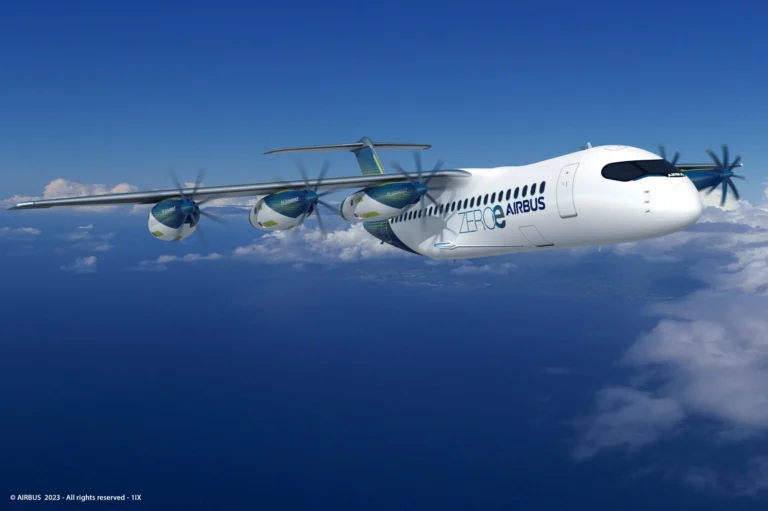The aviation industry is gearing up to pursue low-carbon technologies as part of the mission to combat climate change. Hydrogen-powered aircraft are emerging as a leading contender in this mission, promising a future where air travel could be virtually emission-free. However, the technology could take some time before it is widely available to the industry.
With an ambitious target to launch the first hydrogen-powered commercial flights by 2035, Airbus is exploring various configurations and propulsion technologies that leverage hydrogen’s potential as a clean fuel.
At the heart of these developments are two primary technologies: hydrogen combustion and fuel cells. These technologies offer promising paths to achieving emission reductions while maintaining the performance and efficiency that the aviation sector demands. However, building a hydrogen-powered aircraft is only part of the challenge. Creating a global ecosystem that supports hydrogen production, distribution, and airport infrastructure is crucial for making this vision a reality.
Hydrogen-powered aircraft are often compared to other decarbonisation strategies, such as sustainable aviation fuel (SAF) and electric propulsion. In a significant stride towards sustainable aviation, Airbus has set an ambitious target to introduce hydrogen-powered aircraft by 2035. Through various concepts and ongoing research, the aerospace giant is aiming to revolutionise air travel with low-carbon technologies.
“The technology will heavily influence the size of the aircraft, which could range from accommodating 100 to 200 passengers, and its range, spanning from 1,000 to 2,000 nautical miles,” Christophe Arnold, Airbus’ Head of Hydrogen Infrastructure at ZEROe Ecosystem, stated.
“Having a hydrogen-powered aircraft is great, but it does need to match airlines requirements, to run on green hydrogen (with the right quantity and affordable cost) and airports must be set up to host and operate it.
“This is why Airbus is actively working on developing the required ecosystem worldwide with all the relevant key players – including airlines, airports, industry partners, energy providers, technology specialists – to make sure that the appropriate hydrogen network will be ready.”
Multi-pronged approach
Airbus is actively working towards the decarbonisation of aviation and is fully aligned with other industry actors with a strong conviction that this future requires parallel and focused efforts on all mitigation options. There are several domains we’re working on to reduce emissions of any type of aircraft we will deliver in the future:
Fleet replacement: Old generation aircraft represent around 70 percent of current airlines´ fleets, there is a significant potential for short-term CO2 reductions through their replacement with today’s modern, fuel efficient aircraft family. Airbus is working on making its aircraft more efficient and preparing the next generation of conventional airliners with technology bricks, allowing significant performance improvements.
New technologies: Airbus is working closely with engine manufacturers to integrate the next generation of engines. The hybridisation of the aircraft propulsion systems will be one of the enablers/technologies to reduce the fuel consumption of its products, optimise the onboard overall energy efficiency and increase the thermal engine efficiency.
Optimised Operations: Continuous climb and descent operations and flight trajectory optimisation with real-time transmissions of four-dimensional trajectory data while working on disruptive practices, such as formation flying. Airbus is taking an active role in SESAR, a Joint Undertaking whose role is to modernise the ATM in Europe, and leading some research projects like Albatross (over 1,000 flights with optimised ATM conducted with airlines), which is now being scaled into the Heron demonstrator.
Increased use of SAF: All Airbus commercial, helicopter and military aircraft are already capable of flying with up to 50 percent SAF fuel blend. Today, SAF can reduce CO2 emissions by 80 percent on average throughout its life cycle. The company aims to make our commercial aircraft fleet capable of flying with up to 100 percent SAF by 2030. Airbus is also partnering with the ecosystem to accelerate production of SAF in many different countries.
Securing the infrastructure
Airbus recognised that infrastructure development will be critical to the success of hydrogen-powered aviation, particularly in terms of hydrogen production and distribution. To support its ZEROe project, Airbus has partnered with stakeholders across the global energy sector to ensure a stable supply chain for hydrogen.
As a first step, the simpliest way to support the first years of ZEROe’s operations is to supply liquid hydrogen by liquid hydrogen ground refuelers and trailer trucks from the nearest existing hydrogen facilities.
Geographical features and access to renewable energies will heavily influence the infrastructure set up that airports will have to develop.
“Airports are rethinking how their infrastructures could be designed and operated to reduce their overall emission footprint. One promising option is to build a unique airport ecosystem with hydrogen at the core of operations,” Arnold explained.
“The main airport-controlled activities are: emissions from airport buildings (heating, cooling, lighting), ground support vehicles, and other operations such as baggage handling and fuelling.
“Our Airbus-developed concept involves collaborating with airports to develop a stepped approach to decarbonise airport facilities, ground operations and transportation (heavy goods logistics, buses, tow trucks) using hydrogen.”
Effective transition
Since 2020, Airbus has launched several partnerships across the world with energy providers, airlines, airports to study the potential of hydrogen-powered aircraft and enable hydrogen-powered aviation by 2035.
These studies make it possible to identify the pathways to select which airports will be transformed and/or equipped to operate hydrogen-powered aircraft in both countries as well as the accompanying regulatory framework.
“Initiatives like the Hydrogen Hub at Airports are exactly the kind of project that is bringing all relevant stakeholders around the same table to accelerate adoption and availability of hydrogen for aviation,” Arnold outlined.
“We anticipate that the cost of producing hydrogen is likely to decline over the next decades as it gets widely adopted by various industries (mobility, chemicals, steel, maritime, etc). This will make hydrogen-powered flights increasingly economical.”



